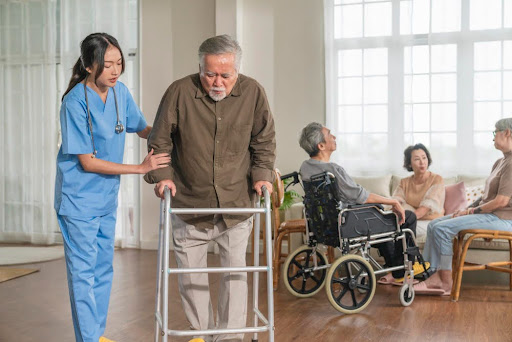When exploring nursing careers, you might come across the terms LVN and LPN and wonder about the differences between LVN and LPN. LVNs (Licensed Vocational Nurses) and LPNs (Licensed Practical Nurses) play vital roles in healthcare. They provide essential care to patients.
The good news is that there is no significant difference in their roles or duties. The distinction lies mainly in the names, which vary by location. LVN is used in California and Texas, while LPN is used in the rest of the United States.

Both LVNs and LPNs work under the supervision of registered nurses (RNs) and doctors. They perform tasks such as monitoring vital signs, administering medications, and assisting with daily activities. They are essential in ensuring patients receive the necessary care and support in various healthcare settings, including hospitals, nursing homes, and clinics.
Though the job roles are kind of the same, there are slight differences between LVN and LPN. The differences between LVN and LPN come down to 5 points:
- Terminology and geography
- Education and Training
- Roles and responsibilities
- Work environment
- Salary and Job Outlook
Understanding Licensed Vocational Nurses – LVN
Licensed Vocational Nurses (LVNs) are essential healthcare professionals who provide basic medical care to patients under the supervision of registered nurses (RNs) and doctors. They are responsible for a range of duties that ensure the well-being and comfort of patients. LVNs typically work in various settings, including hospitals, nursing homes, clinics, and private homes.
One of the primary roles of an LVN is to monitor patients’ vital signs, such as blood pressure, temperature, and heart rate. They also administer medications, change dressings, and assist with basic care tasks like bathing, dressing, and feeding. LVNs are trained to recognize changes in patient’s conditions and report these to RNs or doctors for further evaluation and treatment.

To become an LVN, individuals must complete a state-approved educational program, which typically lasts about one year. These programs are offered at community colleges, vocational schools, and sometimes through hospitals.
After completing their education, aspiring LVNs must pass the National Council Licensure Examination for Practical Nurses (NCLEX-PN) to obtain their license and practice legally.
Understanding Licensed Practical Nurses – LPN
Licensed Practical Nurses (LPNs) are vital members of the healthcare team. They provide basic nursing care under the supervision of registered nurses (RNs) and doctors. LPNs work in various settings, including hospitals, nursing homes, clinics, and private homes, where they play a crucial role in patient care.
The primary responsibilities of LPNs include monitoring patients’ vital signs, such as blood pressure, temperature, and heart rate. They administer medications, change dressings, and assist with daily living activities like bathing, dressing, and feeding.
LPNs are trained to observe changes in patients’ conditions and promptly report these to RNs or doctors for further evaluation and treatment.

To become an LPN, individuals must complete a state-approved educational program, usually offered at community colleges and vocational schools. These programs typically take about one year to complete.
After finishing their education, aspiring LPNs must pass the National Council Licensure Examination for Practical Nurses (NCLEX-PN) to obtain their license and practice legally.
Differences Between LVN And LPN
Now let’s look at the 5 differences between LVN and LPN in detail:
Licensed Vocational Nurses (LVNs) and Licensed Practical Nurses (LPNs) are essentially the same in terms of roles and responsibilities. However, there are some key differences related to terminology and geography.
Terminology and Geography
One of the primary differences between LVN and LPN is their title, which varies by state. The term “Licensed Vocational Nurse” (LVN) is used exclusively in California and Texas. In the rest of the United States, the term “Licensed Practical Nurse” (LPN) is used.
Despite this difference in nomenclature, both LVNs and LPNs perform identical duties and have the same scope of practice.
Education and Training
The educational path for both LVNs and LPNs is nearly identical. Both require completion of a state-approved nursing program, typically offered at community colleges, vocational schools, and sometimes hospitals.
These programs usually take about one year to complete and cover essential nursing skills, patient care, and medical procedures. After finishing their education, both LVNs and LPNs must pass the National Council Licensure Examination for Practical Nurses (NCLEX-PN) to become licensed to practice.
Roles and Responsibilities
LVNs and LPNs share the same roles and responsibilities in the healthcare setting. Their primary duties include monitoring patients’ vital signs, administering medications, changing dressings, and assisting with daily living activities such as bathing, dressing, and feeding.
They also observe and report changes in patients’ conditions to registered nurses (RNs) or doctors, ensuring that patients receive timely and appropriate care.
Work Environments
Both LVNs and LPNs can work in various healthcare settings, including hospitals, nursing homes, clinics, and private homes. Their roles are critical in providing hands-on patient care and supporting the healthcare team in delivering quality services.
Salary and Job Outlook
Since LVNs and LPNs perform the same roles, their salary ranges and job outlook are similar. Both are well-compensated for their work, with wages varying depending on the location, type of facility, and level of experience.
The demand for LVNs and LPNs is expected to grow, driven by an aging population and an increasing need for healthcare services.
Career Opportunities for LVNs and LPNs
Licensed Vocational Nurses (LVNs) and Licensed Practical Nurses (LPNs) have a wide range of career opportunities in the healthcare field. Their foundational nursing skills allow them to work in various settings, providing essential care to diverse patient populations.
Healthcare Facilities
Though there are some differences between LVN and LPN a bit noticeable, they are commonly employed in hospitals, nursing homes, and long-term care facilities. In these environments, they provide direct patient care, monitor vital signs, administer medications, and assist with daily activities.
They play a crucial role in supporting the healthcare team and ensuring patients receive high-quality care.
Home Healthcare
Home healthcare is another growing field for LVNs and LPNs. In this setting, nurses visit patients in their homes to provide medical care and support. This can include wound care, medication management, and helping patients with chronic conditions manage their health.

Working in home healthcare offers nurses the opportunity to build strong relationships with their patients and provide personalized care.
Clinics and Physician Offices
LVNs and LPNs can also work in outpatient clinics and physician offices, where they assist with routine exams, administer vaccines, and provide patient education. These roles often offer more regular hours compared to hospital shifts, appealing to those seeking a better work-life balance.
Specialized Areas
With additional training and certifications, LVNs and LPNs can specialize in areas such as gerontology, pediatrics, or intravenous (IV) therapy. Specializing allows nurses to focus on specific patient populations or types of care, enhancing their expertise and career prospects.
Conclusion
Hope you understand the differences between LVN and LPN clearly. Licensed Vocational Nurses (LVNs) and Licensed Practical Nurses (LPNs) are essential to healthcare, providing vital care and support to patients. Although LVNs work in California and Texas and LPNs work elsewhere, their roles are nearly identical.
They perform crucial tasks like monitoring vital signs, administering medications, and assisting with daily activities in various settings, including hospitals and home healthcare.
These nurses are key members of the healthcare team, ensuring patients receive high-quality care. With opportunities for specialization and career growth, LVNs and LPNs continue to make significant impacts. Their dedication to patient care embodies the true spirit of compassionate healthcare, greatly enhancing patient well-being and recovery.
Frequently Asked Questions
What is the primary difference between an LVN and an LPN?
The primary difference is geographical. LVN (Licensed Vocational Nurse) is used in California and Texas, while LPN (Licensed Practical Nurse) is used in the rest of the United States. Their roles and responsibilities are essentially the same.
What are the main duties of an LVN/LPN?
LVNs and LPNs monitor vital signs, administer medications, change dressings, and assist with daily living activities such as bathing, dressing, and feeding. They report changes in patient’s conditions to RNs or doctors.
What education is required to become an LVN/LPN?
Becoming an LVN/LPN requires completing a state-approved nursing program, typically lasting about one year, followed by passing the NCLEX-PN exam.
In which settings can LVNs and LPNs work?
LVNs and LPNs can work in hospitals, nursing homes, clinics, physician offices, and home healthcare. They can also specialize in areas like geriatrics or pediatrics with additional training.
How do state regulations affect the scope of practice for LVNs and LPNs?
State regulations can slightly vary, affecting specific duties that LVNs and LPNs can perform. Nurses need to understand the regulations in their state.
What career advancement opportunities are available for LVNs and LPNs?
LVNs and LPNs can pursue advanced certifications, specialize in specific areas of care, or continue their education to become Registered Nurses (RNs).
Why is early detection of diabetic foot ulcers important for LVNs and LPNs?
Early detection helps prevent infections, avoid severe complications like amputations, reduce healthcare costs, and maintain a better quality of life for patients.

Leave a Reply